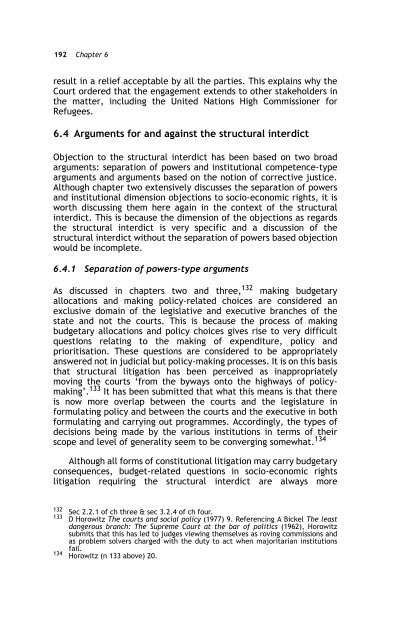LITIGATING SOCIO-ECONOMIC RIGHTS IN SOUTH AFRICA - PULP
LITIGATING SOCIO-ECONOMIC RIGHTS IN SOUTH AFRICA - PULP
LITIGATING SOCIO-ECONOMIC RIGHTS IN SOUTH AFRICA - PULP
You also want an ePaper? Increase the reach of your titles
YUMPU automatically turns print PDFs into web optimized ePapers that Google loves.
192 Chapter 6<br />
result in a relief acceptable by all the parties. This explains why the<br />
Court ordered that the engagement extends to other stakeholders in<br />
the matter, including the United Nations High Commissioner for<br />
Refugees.<br />
6.4 Arguments for and against the structural interdict<br />
Objection to the structural interdict has been based on two broad<br />
arguments: separation of powers and institutional competence-type<br />
arguments and arguments based on the notion of corrective justice.<br />
Although chapter two extensively discusses the separation of powers<br />
and institutional dimension objections to socio-economic rights, it is<br />
worth discussing them here again in the context of the structural<br />
interdict. This is because the dimension of the objections as regards<br />
the structural interdict is very specific and a discussion of the<br />
structural interdict without the separation of powers based objection<br />
would be incomplete.<br />
6.4.1 Separation of powers-type arguments<br />
As discussed in chapters two and three, 132 making budgetary<br />
allocations and making policy-related choices are considered an<br />
exclusive domain of the legislative and executive branches of the<br />
state and not the courts. This is because the process of making<br />
budgetary allocations and policy choices gives rise to very difficult<br />
questions relating to the making of expenditure, policy and<br />
prioritisation. These questions are considered to be appropriately<br />
answered not in judicial but policy-making processes. It is on this basis<br />
that structural litigation has been perceived as inappropriately<br />
moving the courts ‘from the byways onto the highways of policymaking’.<br />
133 It has been submitted that what this means is that there<br />
is now more overlap between the courts and the legislature in<br />
formulating policy and between the courts and the executive in both<br />
formulating and carrying out programmes. Accordingly, the types of<br />
decisions being made by the various institutions in terms of their<br />
scope and level of generality seem to be converging somewhat. 134<br />
Although all forms of constitutional litigation may carry budgetary<br />
consequences, budget-related questions in socio-economic rights<br />
litigation requiring the structural interdict are always more<br />
132 Sec 2.2.1 of ch three & sec 3.2.4 of ch four.<br />
133 D Horowitz The courts and social policy (1977) 9. Referencing A Bickel The least<br />
dangerous branch: The Supreme Court at the bar of politics (1962), Horowitz<br />
submits that this has led to judges viewing themselves as roving commissions and<br />
as problem solvers charged with the duty to act when majoritarian institutions<br />
fail.<br />
134 Horowitz (n 133 above) 20.
















